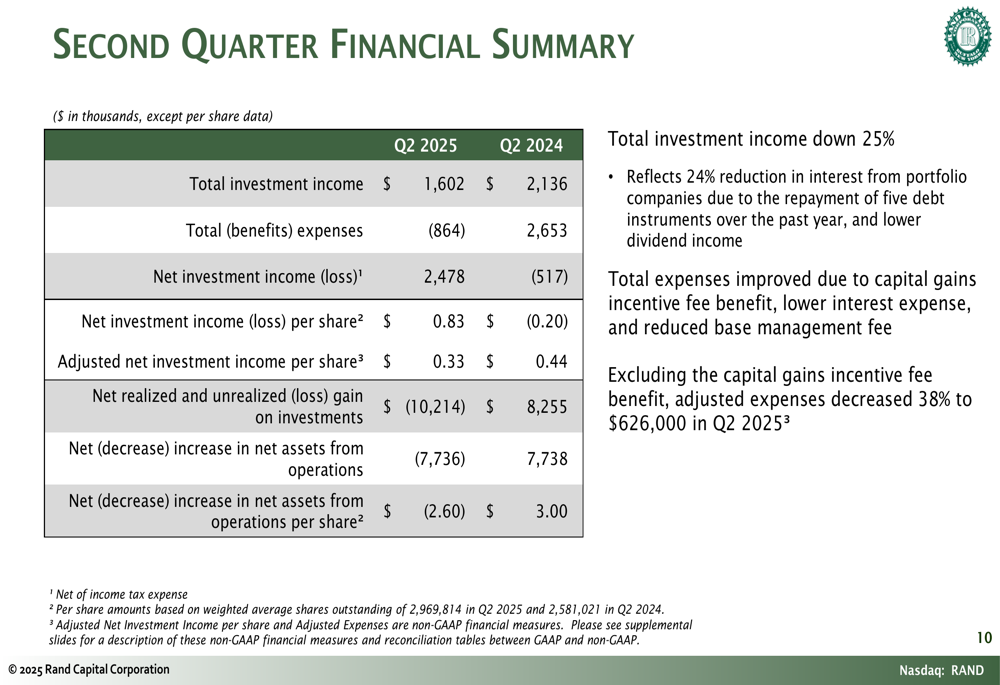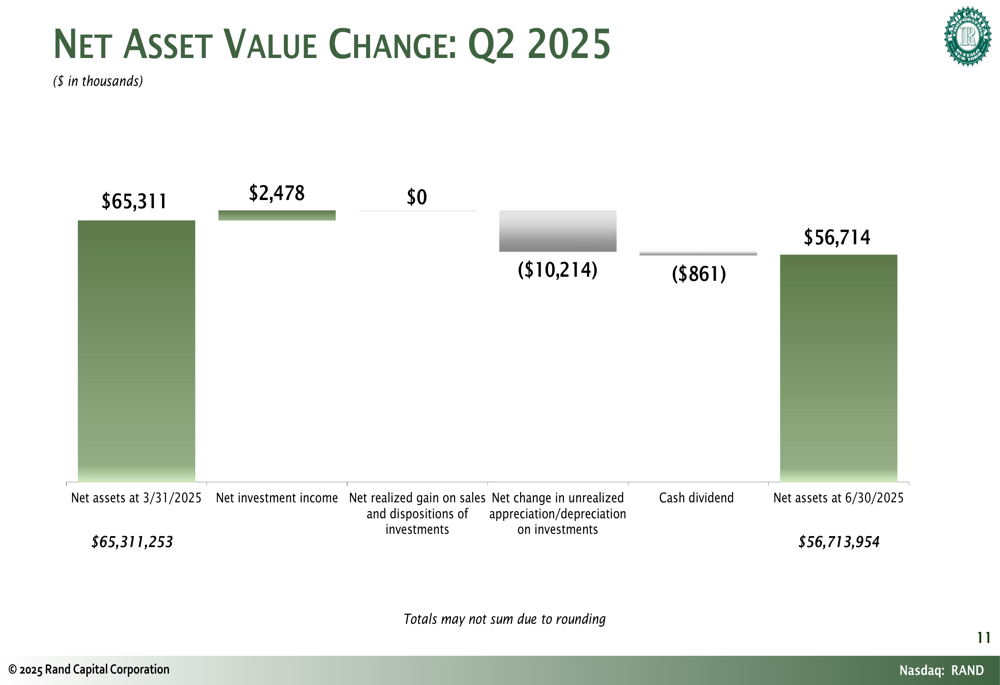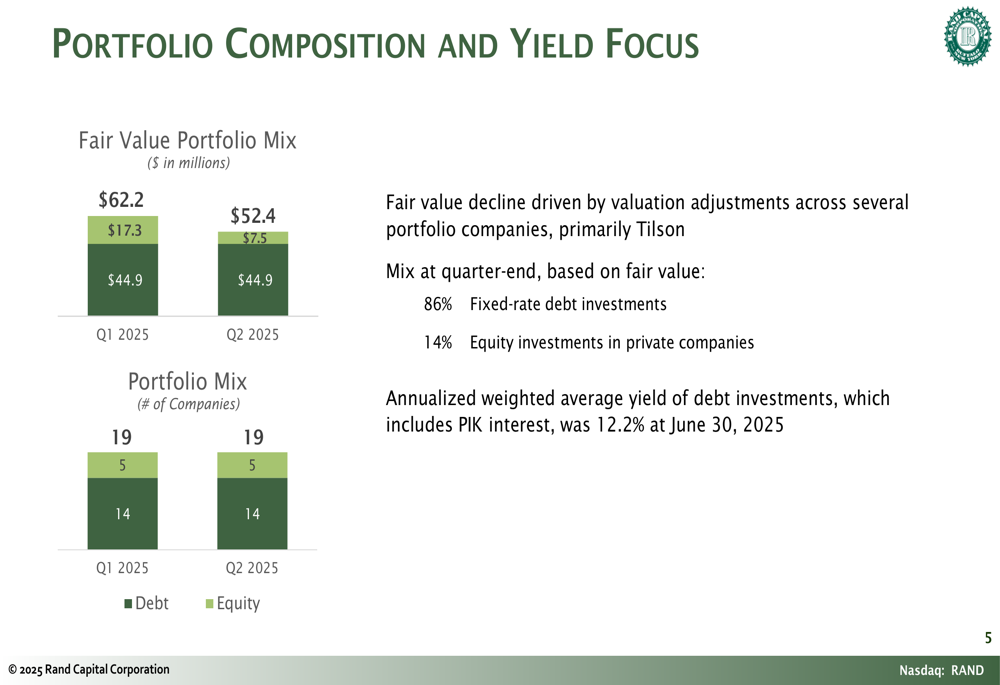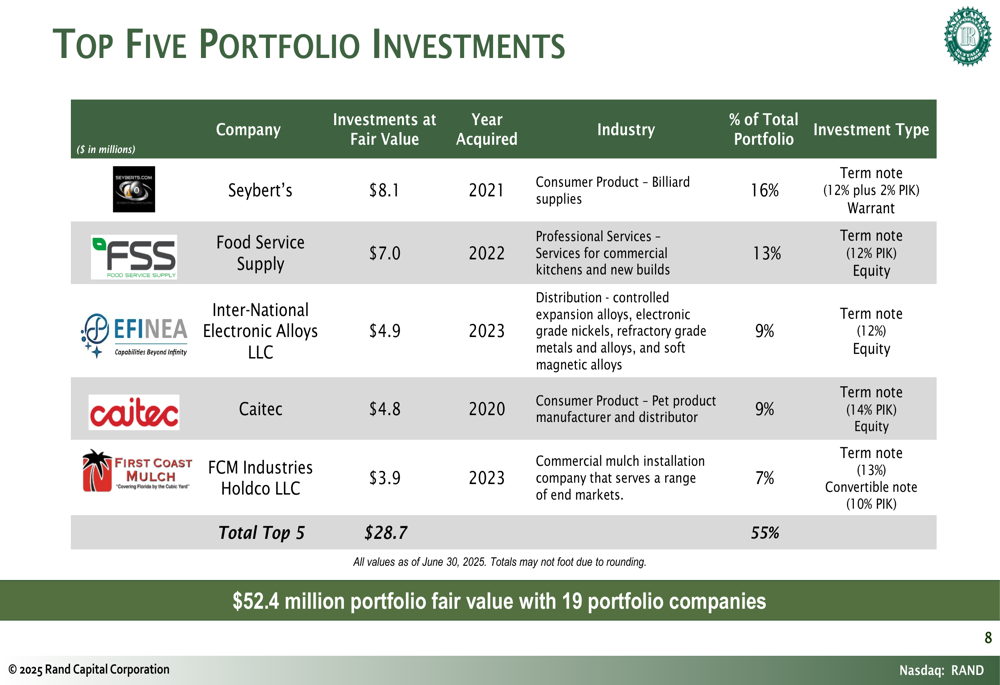Five things to watch in markets in the week ahead
Rand Capital Corporation (NASDAQ:RAND) presented its second quarter 2025 financial results on August 4, 2025, revealing a mixed performance characterized by increased net investment income despite a significant NAV decline due to a major portfolio writedown. The company’s stock closed at $18.23 on August 1, 2025, down 0.65% for the day.
Quarterly Performance Highlights
Rand Capital reported a substantial increase in net investment income to $2.5 million ($0.83 per share) in Q2 2025, compared to a loss of $517,000 (-$0.20 per share) in the same period last year. However, this improvement occurred despite a 25% year-over-year decline in total investment income to $1.6 million, down from $2.1 million in Q2 2024.
The company’s bottom line benefited significantly from a reversal of capital gains incentive fees, which resulted in total expenses becoming a benefit of $864,000 versus an expense of $2.7 million in the prior-year period. When adjusted to exclude these fee reversals, the adjusted net investment income was $0.33 per share, down from $0.44 per share in Q2 2024.
As shown in the following financial summary chart:

The quarter’s results were heavily impacted by a $10.2 million net unrealized loss on investments, primarily due to a $9.5 million writedown of Rand’s investment in Tilson Technologies after it filed for Chapter 11 bankruptcy protection. This contrasts sharply with the $8.3 million net realized and unrealized gain recorded in Q2 2024.
The following chart illustrates the changes in Net Asset Value during the quarter:

Portfolio Composition and Investment Activity
Rand Capital’s portfolio fair value decreased to $52.4 million at quarter-end, down from $62.2 million at the end of Q1 2025. This decline was primarily attributed to the Tilson valuation adjustment. The portfolio remained diversified across 19 companies, with the composition shifting to 86% fixed-rate debt investments and 14% equity investments based on fair value.
The portfolio composition and its evolution from Q1 to Q2 2025 is illustrated in the following chart:

Investment activity during the quarter was limited, with only a $35,000 follow-on equity investment in Carolina Skiff. The company’s portfolio maintained an annualized weighted average yield of 12.2% on debt investments, including PIK (payment-in-kind) interest.
The industry diversification of the portfolio shifted slightly, with Professional Services decreasing from 45% to 37% of the portfolio, while Consumer Products increased from 21% to 25%. The company’s top five investments represented 55% of the total portfolio value.
The following chart details Rand’s top five portfolio investments:

Financial Analysis
The net asset value per share decreased to $19.10 as of June 30, 2025, compared to $21.99 reported at the end of Q1 2025. This 13% quarterly decline was primarily driven by the Tilson writedown, partially offset by net investment income.
Total (EPA:TTEF) assets decreased 20% year-over-year to $57.6 million. Despite the challenges, Rand maintained a strong liquidity position with $4.4 million in cash, up from $835,000 a year ago, though slightly down from the $4.9 million reported at the end of Q1 2025.
The company’s capital position remains strong with no leverage, as illustrated in this breakdown:

Capital Position and Dividend Strategy
Rand Capital maintained its quarterly dividend at $0.29 per share for the third quarter of 2025, continuing its commitment to providing shareholder returns. The company has raised its dividend for three consecutive years, according to previous reports.
The company’s dividend history and yield trend are shown in the following chart:

Rand’s strong capital position includes no outstanding balance on its senior secured revolving credit facility, with $20.2 million in available credit capacity. This positions the company well to capitalize on new investment opportunities as market conditions improve.
Forward-Looking Statements
Looking ahead, Rand Capital emphasized its focus on executing a long-term strategy supported by a resilient, yield-focused investment model. Management indicated they are monitoring early signs of market improvement to reaccelerate deal activity, while prioritizing income-generating debt investments to drive earnings and NAV growth.
"We’re executing our long-term strategy supported by a resilient, yield-focused investment model," stated the company in its presentation. Rand plans to leverage its liquidity and credit capacity to capitalize on emerging opportunities while maintaining rigorous investment underwriting and proactive portfolio oversight.
The company remains committed to pursuing consistent quarterly dividends supported by sustainable income, reinforcing NAV through disciplined capital allocation and expense management, and preserving balance sheet strength while remaining opportunistic in its investment approach.
As market conditions evolve, Rand Capital appears well-positioned to navigate ongoing challenges while maintaining its focus on long-term value creation for shareholders, despite the significant impact of the Tilson writedown on current results.
Full presentation:
This article was generated with the support of AI and reviewed by an editor. For more information see our T&C.
